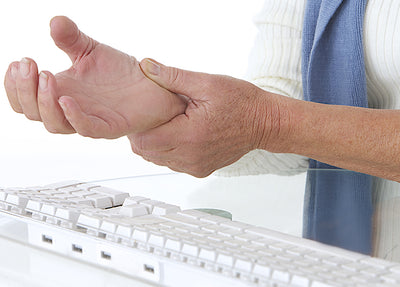
Relieving Your Pressure
When was the last time you questioned whether you could open a jar? If you’re among the one million people with carpal tunnel syndrome, this thought is far too common.
As this disorder strengthens its grasp, what began as a strange tingle transforms into debilitating pain. If you think this syndrome is reserved for the elderly, think again. With the immersion of computers and smartphones into our everyday lives, carpal tunnel syndrome is affecting both young and old. But why?
In essence, this disorder is the result of repetitive, forceful or awkward hand movements. So how do we protect ourselves, and most importantly, treat this painful condition? To find these answers, we must look its causes.
Most Common Carpal Tunnel Causes and Risk Factors
Contrary to what many people think, carpal tunnel syndrome didn’t suddenly appear during the computer boom of the 1990s. The first verifiable case was officially documented in the 1880s. Whether the Industrial Revolution is the underlying culprit may never be known.
But what we do know is even those without a history of engaging in repetitive or awkward wrist movements can still succumb to this disorder.
Topping the list are jobs or activities requiring repetitive finger or wrist movement. Of course, computer use is a culprit. However, assembly line workers are three times more likely to develop carpal tunnel than data entry workers.
It seems even gender plays a role. Women are at a three times increased risk of this disorder than men. As we understand this disorder more, multiple risk factors become clear. These include:
- Dislocating or fracturing your wrist
- Diabetes and alcoholism
- Thyroid disorder, known as hypothyroidism
- Old age
- Heredity
So what exactly causes this painful disorder? In short, inflammation and nerve pressure.
Your carpal tunnel houses a network of nerves and blood vessels, namely the median nerve. Symptoms are the result of excess pressure being placed on this nerve. This occurs when the tunnel is too narrow or when synovium tissues surrounding flexor tendons swell. This swelling creates damaging pressure, which results in the painful symptoms associated with carpal tunnel.
Symptoms of a Syndrome - What Carpal Tunnel Feels Like
At first, symptoms are barely noticeable. For many, these unsavory sensations come and go without rhyme or reason. But, as the disorder progresses, symptom severity worsens. Eventually, symptoms strike more frequently and last longer.
Universal carpal tunnel symptoms include:
- Strange sensations, such as tingling, burning or numbness, in fingers.
- Radiating electrical shocks in your ring, middle, index fingers or thumb.
- Tingling pain radiating out from your forearm up to your shoulder.
- Decreased hand mobility or functionality
Attaining Carpal Tunnel Relief - Effective Treatments and Remedies
Finding long-term carpal tunnel relief is paramount to retain mobility and comfort. As with many disorders, your ideal carpal tunnel treatment may differ based on your specific case. For some, physical therapy is enough. Others, however, may require more invasive treatments.
Carpal tunnel treatments and remedies include:
Physical Therapy
Physical, or occupational, therapy is effective at reducing tension in tendons. Through a series of carpal tunnel exercises, tendons become more flexible. This may help reduce median nerve pressure and increase hand mobility.
Easy and Effective Home Remedies
Carpal tunnel home remedies and natural treatments range from wrist braces to topical application of herbal ingredients. Sometimes, simply being more mindful of stressors and triggers can offset symptoms.
For example, make sure to consistently break away from repetitive tasks every 15 to 30 minutes. Step away from the task, and wiggle your fingers while stretching your hands and wrists. Warmer wrists and fingers tend to remain more flexible. Try wearing fingerless gloves or have a hand warmer nearby.
Other Nonsurgical Treatment Options
Over-the-counter anti-inflammatory medications, or NSAIDs, can temporarily reduce inflammation and pain. For severe cases, steroid injections may be recommended by your physician. However, these only provide temporary relief.
Surgical Treatment for Severe Cases
If nonsurgical methods aren’t working, your physician may consider surgical options. Typically this outpatient procedure increases carpal tunnel diameter to reduce pressure on your median nerve. While relatively minor pain and stiffness is common immediately following surgery, hand strength is noticeably improved after several months and pain symptoms are significantly reduced.
Sources:
Ulster Medical Journal - Carpal Tunnel Syndrome
WebMD - Is Your Smartphone Giving You Carpal Tunnel?
Cleveland Clinic - Carpal Tunnel Syndrome
NIH - Carpal Tunnel Syndrome Fact Sheet
American Academy of Orthopaedic Surgeons
Johns Hopkins Medicine - Carpal Tunnel Syndrome


 {{/image.src}}
{{/image.src}}





